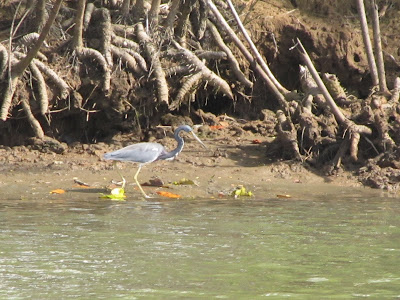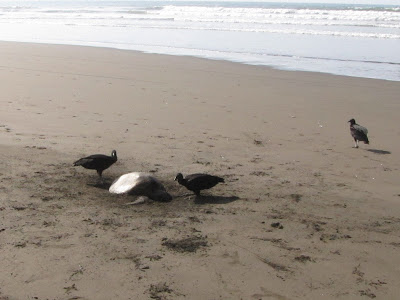 Royal Tern, Playa Herradura, Costa Rica
Royal Tern, Playa Herradura, Costa RicaI was ready to be ambivalent about Los Sueños. It has a mixed reputation in the tour books, seen as a particularly aggressive development project and an English-speaking colony in a Spanish-speaking country.
But then I discovered the warbler trees and the macaw bushes...
We only had a half a day, really, at Los Sueños. It was our final stop and our launching point for the drive back to the airport the next day. I had a couple of hours in the afternoon to explore the grounds.
By the way, the beach at Los Sueños isn't much of a "beach" but it IS teeming with wildlife. Herons and egrets of all sorts, whimbrels, willets, and spotted sandpipers.

We rented a kayak and took a tour of the bay--very calm water but beware the jet skiers--and got stunning views of the environs, including close-up looks at the royal tern (above) and brown pelicans hanging out a buoy.

OK, about the warbler trees and the macaw bushes...
I spent most of my time at one magical place, the bridge connecting the hotel area with the club area on the way to the marina. Working the river, the now exceedingly familiar bare-throated tiger heron

with its compatriots, the white ibises.

and then a ringed kingfisher flew up (I'm not sure I even want to know what it has in its grasp).

Working the trees along the riverbank were warblers, both yellow

and, especially, Tennessee.


and this interesting bird, which I took for a warbler until I saw its beak

--a red-legged honeycreeper in non-breeding plumage, it turns out.
Also, myriad noisy palm tanagers (much more beautiful than they appear in field guides)


and then, just everything else
Clay-colored robin (Costa Rica's national bird)

orange-chinned parakeet
 (you should be able to recognize this bird by now!)
(you should be able to recognize this bird by now!)and a tiny common tody flycatcher

Crossing the bridge, and recording my giant iguana encounters,


I heard a now-familiar squawk. Macaws! I looked around and saw the pair land in a nearby tree.



They left flying directly over pool at the Marriott.
(The Marriott has clearly managed its relationship effectively with this scarlet macaw pair).On to the marina, with its mangrove swallows

and a glimpse of what the area must have looked like before development (sigh)

by now, birding fatigue had set in
Oh another hummingbird
 I can't ID it but I do like the way it's sticking out its tongue...
I can't ID it but I do like the way it's sticking out its tongue...I finally cracked when I saw this non-descript finch

grassquit? seed-eater? I should have been excited, but I just felt very tired
(and the field guides haven't been very helpful either, though I believe it is female blue-black grassquit).It was time to go home. Time for one more gorgeous sunset.

Up at six the next morning, I stepped out into the narrow balcony and surveyed the scene. Hey, look at that, a female Baltimore oriole.

See you in May!
Well, that's it. A once-in-a-lifetime Costa Rica trip, a splendid 25th anniversary destination, with some good birding on the side. I hope you enjoyed this series of posts. Please email me or comment here if you have any questions.



















































